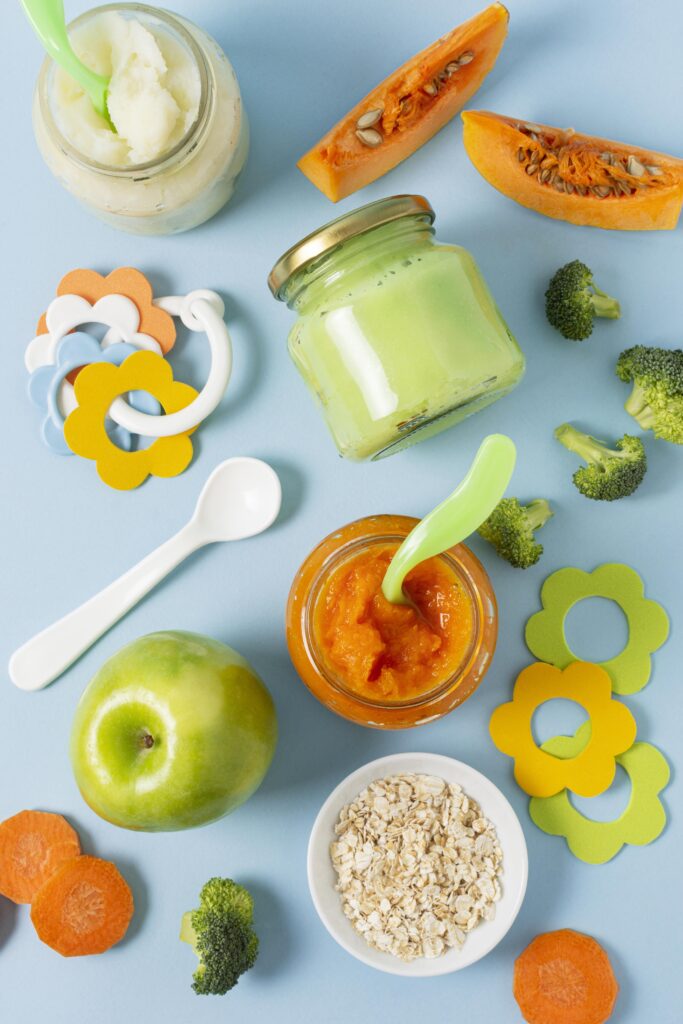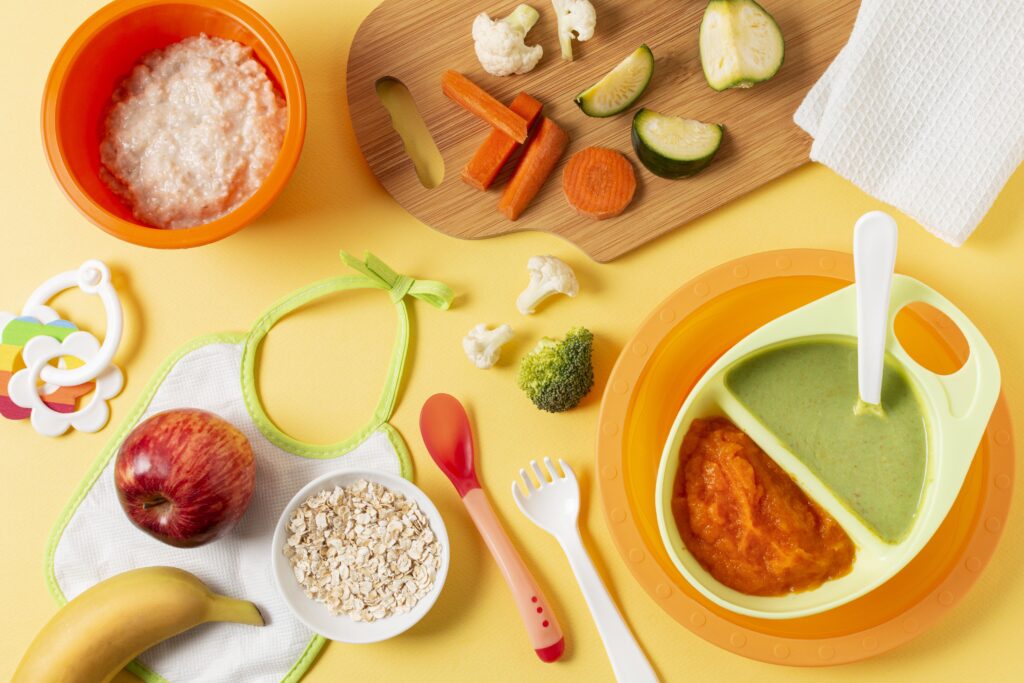Healthy and Tasty Food for Babies
Parenthood is an incredible journey filled with precious moments, and one of the most important aspects is ensuring the health and well-being of your baby. As your little one embarks on their journey of growth and development, providing them with healthy and tasty food becomes a top priority. This article will guide you through the process of introducing solids, selecting nutritious ingredients, preparing meals, and addressing common concerns related to feeding your baby.
Table of Contents
Introduction (Healthy and Tasty Food for Babies)
Introducing your baby to a variety of healthy and tasty foods is crucial for their overall development. Nutritious meals support their physical growth, cognitive development, and immune system, setting the foundation for a healthy future. By offering a diverse range of flavors and textures, you can nurture your baby’s taste buds and encourage them to embrace a wide range of foods as they grow.

Healthy and Tasty Food for Babies
Stage-wise Introduction to Solid Foods
Stage 1: Introduction to Solids (Around 6 Months)
At around 6 months, your baby may be ready to explore solid foods. Start with single-ingredient purees like mashed bananas, avocados, or sweet potatoes. These soft foods are easy to swallow and digest, allowing your baby to get accustomed to new tastes.
Stage 2: Expanding the Palate (Around 7-8 Months)
As your baby becomes comfortable with purees, you can gradually introduce mashed or finely chopped fruits, vegetables, and proteins like cooked chicken or lentils. Experiment with different flavors and combinations to expose your baby to a variety of tastes.
Stage 3: Transitioning to Textured Foods (Around 9-12 Months)
Around 9-12 months, your baby can handle slightly textured foods. Offer mashed or soft foods with small lumps to encourage chewing. Introduce finger foods like cooked pasta, small fruits, and steamed vegetables to improve their motor skills.
Stage 4: Toddler Foods (1 Year and Older)
Once your baby turns 1 year old, they can start enjoying a wider range of foods. Offer bite-sized pieces of cooked meats, whole grains, dairy products, and a variety of fruits and vegetables. Ensure the foods are appropriate for their age and cut into small, manageable pieces to prevent choking.

Healthy and Tasty Food for Babies
Key Nutrients for Baby’s Growth and Development
To support your baby’s growth and development, it’s important to include various nutrients in their meals.
Protein (Healthy and Tasty Food for Babies)
Protein is essential for the optimal growth and development of your baby.. Include sources like mashed beans, tofu, well-cooked eggs, and finely chopped poultry or fish in their meals.
Carbohydrates (Healthy and Tasty Food for Babies)
Carbohydrates provide energy for your baby’s activities. Offer mashed or pureed grains like rice, oats, and quinoa, along with fruits and vegetables rich in carbohydrates.
Healthy Fats (Healthy and Tasty Food for Babies)
Healthy fats aid brain development and provide essential nutrients. Avocados, nut butter, and mashed cooked fish are excellent sources of healthy fats for your baby.
Iron (Healthy and Tasty Food for Babies)
Iron is vital for your baby’s cognitive development and energy levels. Include iron-rich foods like pureed meats, lentils, iron-fortified cereals, and leafy green vegetables in their diet.
Calcium (Healthy and Tasty Food for Babies)
Calcium is necessary for strong bones and teeth. Introduce calcium-rich foods like yogurt, cheese, and tofu to support your baby’s bone development.
Vitamins and Minerals (Healthy and Tasty Food for Babies)
Include a variety of fruits and vegetables in your baby’s meals to provide essential vitamins and minerals. Opt for colorful options like pureed carrots, sweet potatoes, and berries to ensure a diverse nutrient intake.
Meal Ideas for Healthy & Tasty Baby Food (Healthy and Tasty Food for Babies)
Making homemade baby food allows you to control the ingredients and flavors your baby experiences.

Healthy and Tasty Food for Babies
Homemade Purees
Mashed banana with a pinch of cinnamon
Pureed spinach and sweet potato blend
Avocado and pear mash
Finger Foods
Steamed broccoli florets
Soft-cooked carrot sticks
Small cubes of ripe mango
Balanced Meal Combinations
Cooked chicken, mashed sweet potatoes, and peas
Lentil puree with brown rice and steamed zucchini
Mashed blueberries mixed with oatmeal and yogurt
Introducing Herbs and Spices
Mildly seasoned mashed butternut squash
Cinnamon-infused applesauce
Pureed green beans with a hint of garlic
Creative Presentation of Food
Fruit purees arranged in the shape of a smiley face
Vegetable sticks served with a yogurt-based dip
Rice cakes cut into fun shapes and topped with mashed berries
Tips for Preparing and Serving Baby Food
Preparing and serving baby food requires attention to detail to ensure your little one’s safety and enjoyment.

Healthy and Tasty Food for Babies
Choosing Fresh and Organic Ingredients
Opt for fresh and organic produce whenever possible to minimize exposure to pesticides and other harmful substances. By doing so, you ensure that your little one is nourished with the finest quality foods abundant in essential nutrients.
Safe Food Preparation and Storage
Maintain proper hygiene during food preparation. Wash your hands thoroughly and sanitize utensils and surfaces before handling baby food. Cook foods thoroughly, and avoid using ingredients that may pose a choking hazard, such as nuts or large chunks of raw vegetables. Store homemade baby food in airtight containers in the refrigerator or freezer to maintain freshness.
Proper Portion Sizes
Offer small portions of food to your baby to prevent overeating. Gradually increase the portion size as they grow and their appetite develops. Pay attention to their cues of hunger and fullness to ensure a balanced and comfortable eating experience.
Introducing New Foods Gradually
Introduce new foods one at a time to monitor for any potential allergies or sensitivities. Wait a few days before introducing another new food to identify any adverse reactions. This approach helps you identify and address any specific dietary needs or intolerances your baby may have.
Avoiding Common Allergenic Foods
Certain foods have a higher risk of causing allergies in babies. These include cow’s milk, eggs, peanuts, tree nuts, fish, shellfish, soy, and wheat. Consult with your pediatrician before introducing these allergenic foods and closely observe your baby for any signs of allergies.
Understanding Picky Eating Behavior
Selective eating is a common aspect of a child’s developmental journey. Babies may show preferences for certain foods, refuse to eat at times, or exhibit resistance to new flavors. Patience and persistence are key in helping your baby embrace a varied diet.
Strategies to Encourage Healthy Eating Habits
Offer a variety of healthy options and let your baby explore different tastes. Keep mealtime relaxed and enjoyable, avoiding pressure or force-feeding. Be a role model by eating a diverse range of foods yourself. Engage your baby in conversation and make mealtimes a positive and social experience.

Healthy and Tasty Food for Babies
Involving Babies in the Cooking Process
Involving your baby in meal preparation can pique their interest and encourage their willingness to try new foods. Allow them to touch and explore ingredients (under supervision) and participate in age-appropriate kitchen tasks. This hands-on experience fosters their curiosity and promotes a positive relationship with food.
The Role of Breast Milk or Formula
Breast milk or formula remains an essential part of your baby’s diet, even as solid foods are introduced.
Continuing Breastfeeding or Formula Feeding
Breast milk or formula provides crucial nutrients, antibodies, and hydration for your baby. It is recommended to continue breastfeeding or formula feeding alongside the introduction of solid foods. As your baby’s solid food intake increases, the frequency and volume of breast milk or formula may gradually decrease.
Transitioning to Solid Foods
Start by offering solid foods after a breastfeeding or formula feeding session when your baby is not overly hungry. This ensures that they are receptive to trying new foods while still receiving their primary source of nutrition.
Ensuring Adequate Hydration
Alongside solid foods, offer water in a sippy cup or an age-appropriate drinking container to keep your baby hydrated throughout the day. Monitor their urine output and consult with your pediatrician if you have any concerns about hydration.

Healthy and Tasty Food for Babies
Food Safety for Babies (Healthy and Tasty Food for Babies)
Maintaining proper food safety practices is crucial to safeguard your baby’s health.
Proper Cleaning and Sanitization
Thoroughly wash all utensils, containers, and surfaces used for preparing baby food with hot, soapy water. Sterilize bottles, nipples, and pacifiers regularly to prevent the growth of harmful bacteria.
Safe Food Handling Practices
Prevent cross-contamination by ensuring proper segregation of raw meats, poultry, and seafood from other food items. Utilize distinct cutting boards and utensils designated for each food group to maintain hygiene and safety standards. Always cook foods to the appropriate temperature and discard any leftovers that have been sitting at room temperature for more than two hours.
Preventing Choking Hazards
As your baby transitions to solid foods, be cautious of choking hazards. Cut foods into small, age-appropriate pieces, and avoid hard, round, or sticky foods that could get lodged in their throat. Always supervise your baby during mealtime and be prepared to respond to choking emergencies.
Conclusion (Healthy & Tasty Food for Babies)
In conclusion, providing healthy and tasty food for your baby is a wonderful opportunity to nurture their growth and development. By following a stage-wise approach, incorporating key nutrients, offering a variety of flavors and textures, and maintaining food safety practices, you can lay a solid foundation for your baby’s lifelong relationship with food. Embrace the journey of introducing solid foods, address picky eating with patience and creativity, and continue to prioritize breastfeeding or formula feeding alongside their solid food adventures. Remember, every meal is an opportunity to foster your baby’s love for nutritious and delicious food.
FAQs (Healthy and Tasty Food for Babies)
Q1: When should I introduce solid foods to my baby?
A1: Around 6 months of age is generally a suitable time to begin introducing solid foods. However, consult with your pediatrician to determine if your baby is developmentally ready.
Q2: How can I ensure my baby gets all the necessary nutrients?
A2: Offer a variety of foods from different food groups, focusing on protein, carbohydrates, healthy fats, iron, calcium, vitamins, and minerals. It is advisable to seek guidance from your child’s pediatrician for personalized dietary recommendations tailored to their individual needs.
Q3: Can I use commercial baby food instead of homemade purees?
A3: Commercial baby foods can be convenient options, but homemade purees allow you to have more control over ingredients and flavors. Choose high-quality, organic commercial baby foods if you opt for them.
Q4: What should I do if my baby refuses to eat certain foods?
A4: It’s common for babies to be selective eaters. Be patient and continue offering a variety of foods. Introduce rejected foods in different forms or combine them with familiar flavors to encourage acceptance.
Q5: How can I prevent food allergies in my baby? A5: Introduce allergenic foods gradually and one at a time, observing your baby for any adverse reactions. Consult with your pediatrician for specific guidelines based on your baby’s risk factors.

